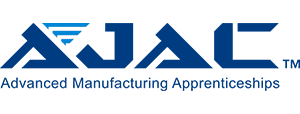A Logistics Specialist ensures that materials, products, and information flow smoothly through the supply chain. They coordinate inventory, shipping, and warehouse operations to keep manufacturing and distribution processes efficient, accurate, and on schedule.
What Does a Logistics Specialist Do?
Program Overview

Train for a Career as a Logistics Specialist
Logistics Specialists play a critical role in modern manufacturing and distribution — ensuring that materials and products move efficiently, safely, and accurately.
As a Logistics Specialist apprentice, you’ll gain foundational supply‑chain skills, hands‑on warehouse and inventory experience, and exposure to advanced systems and technologies.
| Program Length | 18-Months |
| On-the-Job Hours | 3,000 |
| College Classes | 5 |
| College Credits | 25 |

Hands-On Training That Builds Real Skills
You’ll learn the real‑world skills that help keep supply chains running smoothly:
- Procure, receive, stow, issue, and inventory materials in manufacturing and warehouse environments.
- Maintain data and integrity of supply‑management computer systems.
- Generate reports, audit supply‑functions, and support budget‑ and cost‑control logistics processes.
- Apply principles of lean, Six Sigma, and ERP (Enterprise Resource Planning) to reduce waste and optimize operations.
By the end of this apprenticeship, you’ll be equipped to step confidently into leadership logistics roles and support high‑performing supply chains.
Why Apprenticeship Makes Sense

Hands-On Training with Real Employers
AJAC has partnered with 300+ advanced manufacturers to provide supervised, structured, paid on-the-job training.
AJAC apprentices can only work for companies that agree to hire them and place them into the program.
Each company has their own methodology for who they select as an apprentice.

Earn a Paycheck While You Learn
This apprenticeship opens the door to a stable, in‑demand career — combining technology, operations, and logistics in one vital role.
Program Highlights:
- Earn a paycheck while you learn (paid on‑the‑job training)
- Attend classes one evening per week (typically Tuesday‑Thursday, 5 pm‑9 pm)
- Receive college‑level instruction in five classes, earning 5 credits each
- Move into leadership‑track roles like Operations Specialist or Industrial Maintenance Technician after completion.
- Work with modern logistics tools, warehouse systems, and supply‑chain technology
*This is a Washington State average for this occupation. Wage rates vary by employer, industry, experience and location.
Apprenticeship Classes
Classes are held one evening per week (Tuesday–Thursday, 5–9 PM) and are only available online. Tuition: $400 per class (50% reduced rate). Many employers pay the full cost.
In this course, students will explore concepts related to various functions within operations and supply chain management. They will develop an understanding of complex processes to be followed to bring a finished product to life for consumers. Students will explain how new demands, advancing technology, changing preferences, and unforeseen circumstances force companies to adapt to survive and create new products. Students will also gain foundational knowledge, including logistics and warehouse management principals, in a non-technical way to help them understand their work.
Apprentices are introduced to basic communication concepts relating to the workplace. Concepts include theory and skills practice related to interpersonal, intercultural, and production team communications, technical writing and business communications, phone and email etiquette, and conflict management. Students will create a professional portfolio that includes a resume, examples of skills, accomplishments, and samples of work.
In this course, students will be able to relate LEAN Six Sigma concepts to production objectives. They will identify waste within the value stream and demonstrate the ability to effectively analyze and present data to co-workers and stakeholders. They will define and apply team leadership tools to aid in process improvement. Students will collect and process customer or internal stakeholder input/requirements and identify key metrics for measuring success. Students will define the DMAIC process and effectively use tools and concepts associated with each phase of the DMAIC process. Finally, they’ll employ Lean Six Sigma skills in process improvement projects.
In this course, students will describe types of inventory and develop an understanding of the financial accounting of inventory. They will also learn where to locate inventory and ways to control its location. Students will explore the uses, advantages, and disadvantages of automated inventory systems such as bar codes and RFID. They will describe ways to manage inventory and explain causes of inventory system failures as well as ways to fix the problems. Students will also explore some of the basic risks of supply chain management as well as solutions to some common problems. Finally, students will explore the importance of warehouse safety by focusing on injury prevention and reporting, forklift safety, and ergonomics. 8 hours of safety in this course.
Enterprise Resource Planning (ERP) refers to a method or type of software that organizations use to manage day-to-day activities. In this course, students will explore ways that ERP is used to efficiently manage demand and procurement. They will explain how ERP is used to quantify resource use, and better plan production jobs and product delivery. Students will use ERP to create invoices to send directly to customers or create and transmit import and export documentation required for cross-border shipments. Students will also identify how ERP processes enhance collaboration between businesses and vendors, helping to reduce bottlenecks. Students will explore how ERP use can help target inefficiencies in resource use and improve business outcomes. Finally, students will explain how ERP can help organizations adapt during business downturns. 3.5 hours of safety in this course.
3,000 Hours of Hands-On Experience
Apprentices gain hands-on experience with structured tasks to ensure well-rounded expertise.
| OJT Competency | Approx. OJT Hours |
|---|---|
| Inventory & Production Management | 1,000 |
| Distribution & Logistics Operations | 800 |
| Storage & Warehousing Operations | 800 |
| LEAN/6Sigma Projects | 200 |
| Internal & External Customer Service | 200 |
| TOTAL HOURS | 3,000 |
Steps to Becoming an Apprentice


6 Steps to Becoming an Apprentice
Find an Employer Partner: Apply to a company already partnered with AJAC — or, if your employer isn’t yet a partner, they can easily join the program. The process is simple and AJAC will guide them through every step.
Get Company Approval: Your supervisor signs off on apprenticeship participation.
Sign the Apprenticeship Agreement: AJAC visits your employer to finalize.
Start Classes: Enroll in your first college-level course.
Track Hours: Log on-the-job training through AJAC’s Apprentice Tracking System.
Graduate: Earn your Journey-Level Certificate and AJAC Certificate of Completion.

Your Career Starts Here
Ready to launch a logistics and supply‑chain career with growth, technology, and solid earning potential? Join AJAC’s Logistics Specialist apprenticeship — earn while you learn, gain college credits, build your skillset, and finish with a nationally‑recognized credential.
